|
Report from
Europe
EU27 tropical wood import value increases on the back
of high prices
In the first four months of this year, the value of EU
imports of tropical wood and wood furniture totalled
USD1.23 billion, a gain of 28% compared to the same
period last year.
In terms of value, this was by far the highest level of trade
for the four month period in the last five years (Chart 1).
In fact trade value was at a level not seen since before the
2008-2009 financial crises.
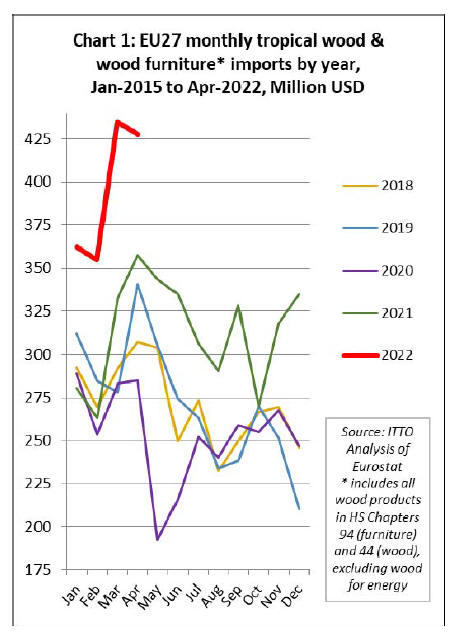
Part of the gain in EU27 tropical wood product import
value in the first four months of this year reflected a rise in
CIF prices, driven both by continuing high freight rates
and severe shortages of wood and other materials due to
logistical challenges during the global pandemic.
In quantity terms, EU imports of tropical wood and wood
furniture products in the first four months of this year
were, at 669,000 tonnes, up 14% compared to the same
period in 2021.
The curtailment of wood supplies from Russia and Belarus
due to the sanctions imposed by the EU following the
invasion of Ukraine in February is opening up new
opportunities in the EU market for some tropical wood
products, notably plywood and decking for which Russian
birch and larch products have been important substitutes.
In the first four months of this year, tropical products
accounted for 8.2% of the quantity of all wood and wood
furniture products imported into the EU27, which
compares to 6.9% during the same period in 2021. The
gain in tropical wood share is due mainly to a 37% and
17% reduction in imports respectively from Russia and
Belarus during this period.
However, larger beneficiaries of the opening supply gap so
far this year have been Norway, China and Brazil (nontropical
products only) (Chart 2).

Rise in EU27 import value for nearly all tropical wood
product groups
There were significant increases in the value of EU27
imports of most wood product groups from tropical
countries in the first four months of this year (Chart 3).
For wood furniture, import value of USD691M during the
January to April period was 18% more than the same
period last year. For tropical sawnwood, import value of
USD297M was 33% up on the same period last year.
Import value of tropical mouldings/decking was
USD154M in the first four months of this year, a gain of
42% compared to the same period in 2021.
There were also large gains in the value of EU27 imports
of tropical joinery products (+63% to USD102M), tropical
veneer (+24% to USD74M), plywood (+50% to
USD71M), marquetry (+88% to USD43M) and flooring
(+40% to USD30M) in the first four months of this year.
Import value of tropical logs was USD17M between
January and April, just 9% more than the same period last
year.
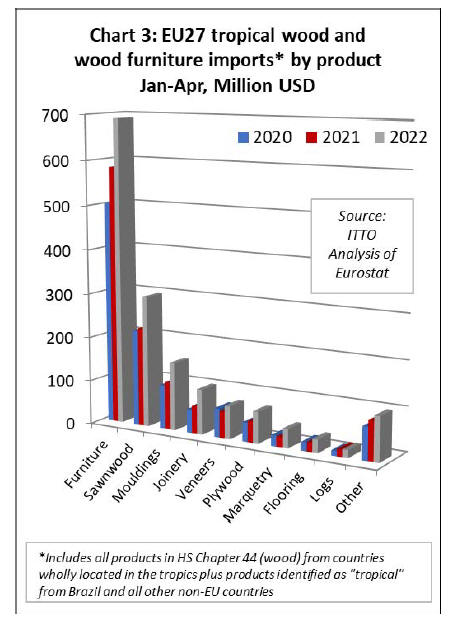
Sharp rise in EU27 wood furniture imports from
Vietnam and Indonesia
In the first four months of 2022, EU27 import value of
wood furniture from tropical countries was USD691M,
18% higher than the same period in 2021. Import value
increased 19% from Vietnam to USD298M, 43% from
Indonesia to USD200M, and 9% from Malaysia to
USD53M.

However imports from India, after increasing sharply last
year, were down 5% to USS122M in the first four months
of this year. Wood furniture imports from Thailand have
continued to slide, down 10% to just USD10M in the first
four months of this year. EU27 wood furniture imports
from all other tropical countries are negligible (Chart 4).
Recovery in EU27 imports of tropical sawnwood
After two slow years during the global pandemic, EU27
imports of tropical sawnwood have shown signs of
recovery this year. Imports of 243,000 tonnes in the first
four months were 18% higher than the same period in
2021 and 37% more than the same period in 2020.
Sawnwood imports increased sharply in the first four
months of this year from all the largest tropical suppliers
to the EU27 including Cameroon (+28% to 78,700
tonnes), Gabon (+24% to 39,700 tonnes), Brazil (+23% to
48,500 tonnes), Congo (+16% to 19,400 tonnes) and
Malaysia (+46% to 20,000 tonnes).
Of smaller supply countries, there was 3% decline from
Côte d'Ivoire to 5,300 tonnes but a 27% increase from
Ghana to 5,800 tonnes and a 155% increase from DRC to
3,500 tonnes (Chart 5).
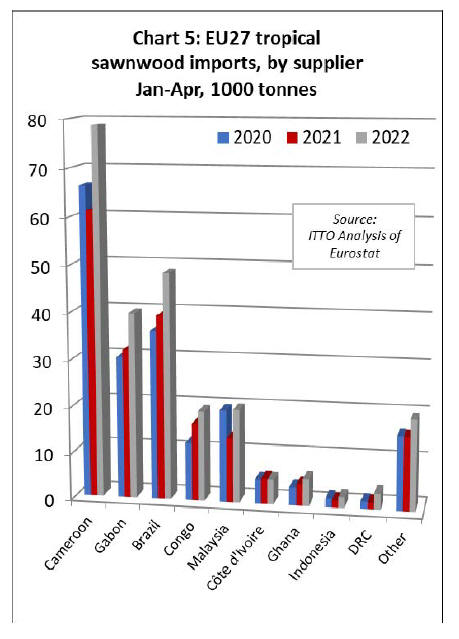
In contrast to sawnwood, EU27 imports of tropical
mouldings/decking were quite slow in the first four
months of this year, most likely due to supply shortages
rather than to limited demand. Imports of 67,700 tonnes
between January and April this year were at the same level
as the same period last year.
Falling imports from the two largest supply countries,
Indonesia (-10% to 22,400 tonnes) and Brazil (-7% to
24,500 tonnes), were offset by rising imports from Peru
(+17% to 5,500 tonnes), Gabon (+98% to 5,500 tonnes),
Bolivia (+33% to 2,600 tonnes), and Malaysia (+19% to
3,000 tonnes) (Chart 6).
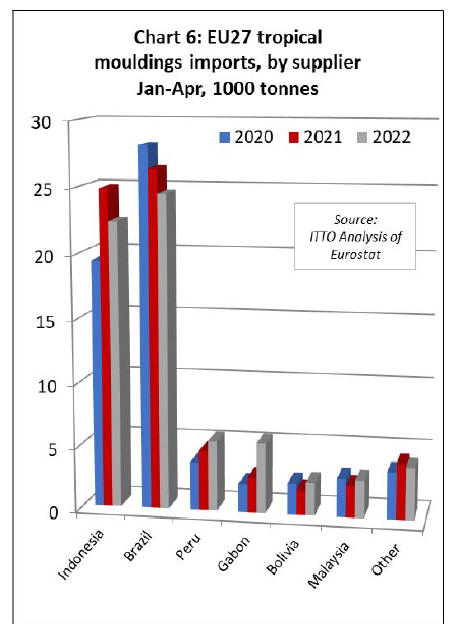
In the first four months of 2022, the EU27 imported
36,900 tonnes of tropical logs, 36% more than the same
period in 2021. The most significant trend was a rise in log
imports from Malaysia, at negligible levels for many
years, to 8,400 tonnes in the first four months of this year
(Chart 7).
The rise coincides with a limited export program by the
Malaysian State of Sabah allowing eligible parties to
export unprocessed timber from natural forests which
began on 3 January this year.
EU27 log imports from the largest African supply
countries declined in the first four months of this year
compared to the same period last year; imports were down
19% to 8,000 tonnes from Congo, down 9% from CAR to
4,900 tonnes, and down 56% from Cameroon to 1,800
tonnes.
However, imports from DRC increased 145% to 5,400
tonnes. Imports from Liberia were level at 3,100 tonnes
during the four month period.
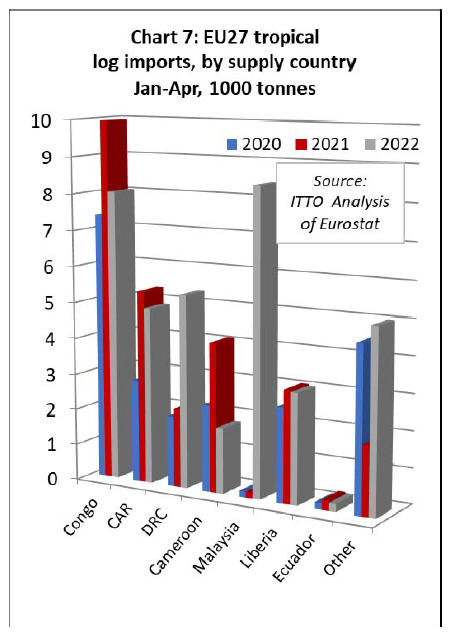
Gabon drives rebound in EU27 imports of tropical
veneer and plywood
In the first four months of 2022, the EU27 imported
49,500 tonnes of tropical veneer, 22% more than the same
period last year. Imports of tropical veneer from Gabon,
by far the largest supplier to the EU27, increased 28% to
26,600 tonnes. There were also large gains in imports from
Côte d'Ivoire (+26% to 9,900 tonnes) and Cameroon
(+47% to 4,700 tonnes), offsetting a sharp decline in
imports from Congo (-46% to 2,100 tonnes) (Chart 8).
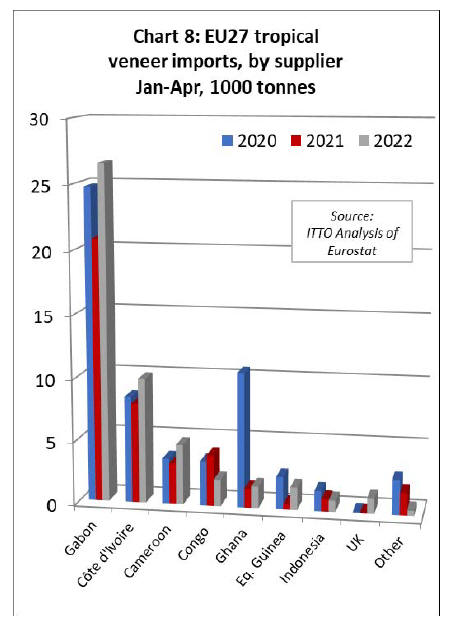
In the first four months of 2022, EU27 tropical plywood
imports of 40,200 tonnes were 11% more than the same
period the previous year. Imports from Indonesia, at
12,300 tonnes, were up 5% compared to the same period
last year.
However, the biggest increase was in imports from Gabon,
rising 84% to 9,500 tonnes. Imports of tropical plywood
also increased 58% to 3,700 tonnes from Morocco. These
gains offset a 42% decline in imports of tropical hardwood
faced plywood from China to 4,700 tonnes (Chart 9).
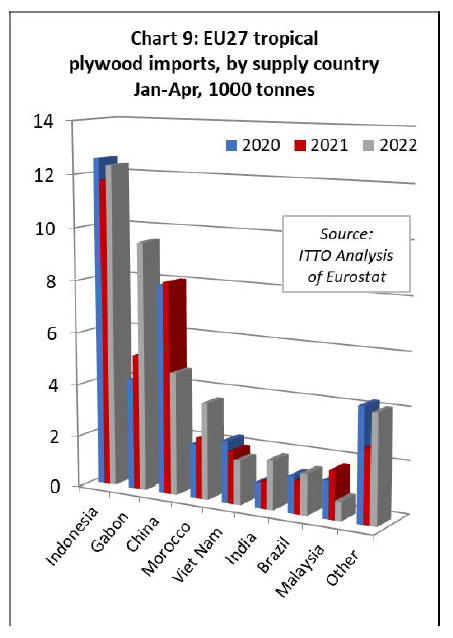
Rise in EU27 imports of tropical flooring from Malaysia
continues
In the first four months of 2022, the EU27 imported 9,400
tonnes of tropical wood flooring, 30% more than the same
period in 2021. The rise in EU27 wood flooring imports
from Malaysia, that began in 2020, has continued this
year.
Imports of 4,900 tonnes from Malaysia in the first four
months of 2022 were 34% more than the same period in
2021. There were also large gains, from a smaller base,
from Indonesia (+41% to 2,100 tonnes) and Vietnam
(+33% to 1,300 tonnes).
However flooring imports from Brazil have continued to
slide this year, at just 600 tonnes in the first four months,
6% down compared to the same period last year (Chart
10).

The value of EU27 imports of other joinery products from
tropical countries - which mainly comprise laminated
window scantlings, kitchen tops and wood doors -
increased 63% to US$103M in the first four months of
2022. Imports were up 55% to USD49M million from
Indonesia, up 43% to USD29M from Malaysia, and up
30% to US$9M from Vietnam (Chart 11).
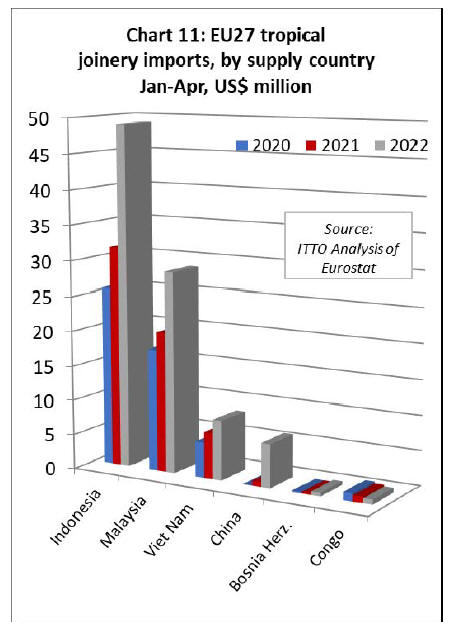
The apparent large increase in imports of this commodity
group from China, from negligible levels to US$6.2M in
the first four months of this year, is due to a change in
product codes from the start of this year allowing more
joinery products manufactured using tropical hardwood in
non-tropical countries to be separately identified.
European Council adopts position on deforestation
law
On 28 June, the European Council adopted its negotiating
position on a proposal to limit the consumption of
products contributing to deforestation or forest
degradation. Now that the Council has agreed its position,
negotiations with the European Parliament can begin so as
to reach an agreement on the final legal text, a process that
could be completed before the end of this year.
According to the European Council press release issued
following the 28 June meeting, the Council agreed to
set mandatory due diligence rules for all operators and
traders who place, make available or export the following
products from the EU market: palm oil, beef, timber,
coffee, cocoa and soy. The rules also apply to a number of
derived products such as leather, chocolate and furniture.
See:https://www.consilium.europa.eu/en/press/pressreleases/2022/06/28/council-agrees-on-new-rules-to-drivedown-deforestation-and-forest-degradation/
The Council agreed to set up a benchmarking system,
which assigns to third and EU countries a level of risk
related to deforestation (low, standard or high). The risk
category would determine the level of specific obligations
for operators and member states¡¯ authorities to carry out
inspections and controls.
This would mean an enhanced monitoring for high-risk
countries and simplified due diligence for low-risk
countries.
The Council simplified and clarified the due diligence
system, while preserving a strong level of environmental
ambition. The general approach avoids duplication of
obligations and reduces administrative burden for
operators and member states¡¯ authorities.
It also adds the possibility for small operators to rely on
larger operators to prepare due diligence declarations.
However the requirement for operators to provide
geolocation of all regulated products placed on the EU
market, irrespective of benchmarked risk, was retained.
The Council clarified the control obligations and set
quantified objectives of minimum control levels for
standard- and high-risk countries. The purpose is to set
effective and targeted measures. The Council maintained
provisions regarding effective, proportionate and
dissuasive penalties and enhanced cooperation with
partner countries, as proposed by the Commission.
The Council modified the definition of ¡®forest
degradation¡¯ to mean structural changes to forest cover,
taking the form of the conversion of primary forests into
plantation forests or into other wooded land. Lastly, the
Council strengthened the human rights aspects of the text,
notably by adding several references to the United Nations
Declaration on the Rights of Indigenous Peoples.
The legal text agreed by consensus at the Council meeting
is available at:
https://data.consilium.europa.eu/doc/document/ST-10284-2022-INIT/en/pdf
An independent briefing on the revisions agreed by the
Council prepared by the law firm HFW which specialises
in international commerce is available at:
https://www.hfw.com/An-Update-European-Union-Draft-Law-Seeking-to-Ban-Imports-and-Exports-of-Commodities-from-Regions-at-Riskof-Deforestation
Views and updates from European based timber trade and
industry organisations following the Council's meeting are
available at:
https://www.atibt.org/en/news/13185/euregulation-on-deforestation-general-approachadopted-by-eu-council
https://www.ceibois.org/_files/ugd/5b1bdc_98cebc2c2a1342bc80b0d626faec2ea8.pdf
Press coverage relating to the Council's agreement
includes:
https://www.politico.eu/article/industry-warnagainst-eu-traceability-plan-preventdeforestation/
https://www.euractiv.com/section/climateenvironment/news/ministers-back-draft-eu-antideforestation-law-derided-as-swiss-cheese-bycampaigners/
https://www.theguardian.com/environment/2022/jul/05/scientists-warn-meps-against-wateringdown-eu-deforestation-law
https://www.foodnavigator.com/Article/2022/07/01/full-of-more-holes-than-swiss-cheese-europeaccused-of-watering-down-its-deforestation-duediligence-regulation
|